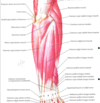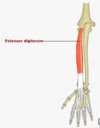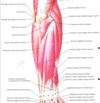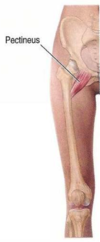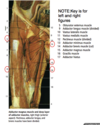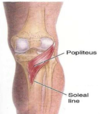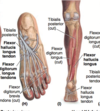Muscles MD3 Flashcards
Deltoid
origin: lateral 1/3 of clavicle, acromion, spine of scapula
insertion: deltoid tuberosity
innervation: axillary nn. (C5, C6)
action:
anterior deltoid: humeral flexion & internal rotation
lateral/middle deltoid: humeral abduction
posterior deltoid: humeral extension & external rotation

Teres Major
origin: posterior surface of inferior angle of scapula
insertion: medial lip of intertubercular/bicipital groove
innervation: lower subscapular nn (C5, C6)
action: adduction & internal rotation of humerus

Teres Minor
origin: mid part of lateral border of scapula
insertion: inferior facet of greater tubercle of humerus
innervation: axillary nn (C5, C6)
actions:
controls internal rotation of humerus (functional action)
external rotation of humerus
*part of rotator cuff (provide dynamic stability via eccentric contraction for shoulder stabilization/re-enforcement of GH joint capsule)

Infraspinatus
origin: infraspinous/infraspinatus fossa of scapula
insertion: middle facet of greater tubercle of humerus
innervation: suprascapular nn (C5, C6)
actions:
controls IR of humerus (functional action)
ER of humerus
*part of rotator cuff (provide dynamic stability via eccentric contraction for shoulder stabilization/re-enforcement of GH joint capsule)

Supraspinatus
origin: supraspinous/supraspinatus fossa of scapula
insertion: superior facet of greater tubercle of humerus
innervation: suprascapular nn (C5, C6)
actions:
prevent superior translation of humeral head during abduction (protect supraspinatus, bursae, etc. from getting pinched by humeral head & acromion) (functional action)
initiate abduction & assist deltoid in abduction of humerus
*part of rotator cuff (provide dynamic stability via eccentric contraction for shoulder stabilization/re-enforcement of GH joint capsule)

Subscapularis

origin: subscapular fossa of scapula (anterior)
insertion: lesser tubercle of humerus
innervation: upper & lower subscapular nn (C5-C7)
actions:
control ER of humerus (functional action)
IR & adduction of humerus
*part of rotator cuff (provide dynamic stability via eccentric contraction for shoulder stabilization/re-enforcement of GH joint capsule)

Pectoralis Minor
origin: ribs 3-5 (highly variable)
insertion: coracoid process of scapula
innervation: medial pectoral nn (C8, T1)
actions:
stabilizes shoulder, draws scapula anterior & depresses it inferiorly towards the thorax (helps upper extremity reach out forward)
divides axillary aa into its 3 parts
(1st part medial to pec minor, 2nd part posterior, 3rd part lateral)
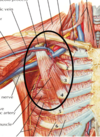
Serratus Anterior
origin: lateral aspects of ribs 1-8
insertion:
upper 4 heads- anterior surface of medial border of scapula,
lower 4- inferior angle of scapula
innervation: long thoracic nn (C5-C7)
actions:
protraction of scapula, holds medial border against thoracic wall, upward rotation/external rotation
long thoracic nn can be damaged during mastectomy (winged scapula), unable to raise arm above horizontal

Pectoralis Major
origin:
clavicular- ant, medial 1/2 of clavicle
sternal- ant sternum, 1st 6 costal cartilages, external oblique aponeurosis
insertion: lateral lip of intertubercular/bicipital groove
innervation: lateral & medial pectoral nn (clavicle C5, C6, sternum C7-T1)
actions:
adduction & IR of humerus, draws scapula anterior & inferior

Triceps brachii
origin:
long head- infraglenoid tubercle of scapula
lateral head- posterior humerus, superior to spiral groove (radial groove)
medial head- posterior humerus, inferior to spiral groove (radial groove)
insertion: olecranon process of ulna
innervation: radial nn (C6-C8)
actions: extension at elbow
heads recruited additively as needed, medial first (workhorse), lateral (strongest), long (last)

Latissimus Dorsi
origin: spinous processes of T7-L5, inferior angle of scapula, thoracolumbar fascia, iliac crest of sacrum, inferior 3 or 4 ribs
insertion: floor of intertubercular/bicipital groove of humerus
innervation: thoracodorsal nn (C6-C8)
actions: adduction, IR & extension of the humerus
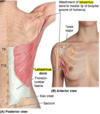
Biceps brachii

brachial aa, musculocutaneous nn (C5, C6)
Long head
origin: supraglenoid tubercle, thru glenoid labrum (constant tension causes slap lesions)
Short head
origin: coracoid process
insertion: radial tuberosity (medial radius) & bicipital aponeurosis
action: primary supinator of forearm, also resistive elbow flexion (hand position dependent)

Coracobrachialis
brachial aa, musculocutaneous nn (C5-C7)
origin: coracoid process
insertion: mid 1/3 of medial humerus
actions: humeral adduction, flexion @ GH joint (shoulder)
- musculocutaneous nn pierces it
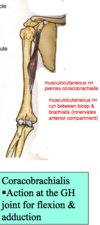
Brachialis
radial recurrent aa, musculocutaneous nn (C5, C6)
origin: anterior humerus
insertion: coronoid process & tuberosity of ulna
actions: primary elbow flexor (active throughout elbow flexion)
- musculocutaneous nn runs between biceps brachii & brachialis

Brachioradialis
radial recurrent aa, radial nn (C5, C6)
origin: lateral supracondylar ridge of humerus
insertion: radial styloid process (distal radius)
actions: elbow flexion
only flexor in the posterior compartment, superficial layer

Pronator teres

ulnar & radial aa, median nn (C6, C7)
origin: medial epicondyle of humerus & coronoid process of ulna
insertion: lateral aspect of mid radius
actions: pronation of forearm, elbow flexion
- superficial anterior compartment

Flexor Carpi Radialis

radial aa, median nn (C6, C7)
origin: medial epicondyle of humerus
insertion: base of 2nd & 3rd metacarpals
actions: flexion & abduction of wrist
- superficial anterior compartment
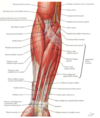
Flexor Carpi Ulnaris

ulnar aa, ulnar nn (C8, T1)
origin: medial epicondyle of humerus
insertion: pisiform, hook of hamate, base of 5th metacarpal
actions: flexion and adduction of wrist
- anterior superficial compartment
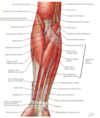
Palmaris Longus

ulnar aa, median nn (C7, C8)
origin: medial epicondyle of humerus
insertion: flexor retinaculum & palmar aponeurosis
actions: wrist flexion, tenses palmar aponeurosis
- anterior superficial compartment
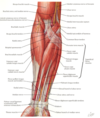
Abductor Pollicis Longus

origin: proximal ulna, radius, interosseus membrane
insertion: base of 1st metacarpal
action: abduction & extension of thumb
innervation: radial nn (deep radial nn) (C7, C8)
*deep layer on posterior forearm
Flexor Digitorum Superficialis
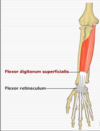
origin: anterior oblique line of radius, coronoid process of ulna, medial epicondyle of humerus
insertion: middle phalanges
innervation: median nn (C7, C8, T1)
action: flexion of middle phalanges @ PIP, then flexion of proximal phalanges @ MCP
Flexor Digitorum Profundus

origin: ulna & interosseus membrane
insertion: distal phalanges (2-5)
innervation: median nn & ulnar nn (4th & 5th digits)
action: flexion of distal phalanges @ DIP
*deep anterior forearm
Flexor Pollicis Longus

origin: radius
insertion: distal phalanx of thumb
innervation: median nn
action: flexion of thumb
*deep anterior forearm

Pronator Quadratus

origin: ulna
insertion: radius
innervation: median nn
action: pronation of forearm
*deep anterior forearm
square “quad” shaped muscle
Abductor pollicis brevis
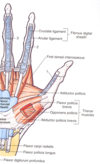
origin: flexor retinaculum, scaphoid, trapezium
insertion: lateral proximal phalanx of thumb
innervation: median nn
action: abduction of thumb
*thenar (palmar base of thumb)
-intrinsic muscle
Flexor Pollicis Brevis

origin: flexor retinaculum, scaphoid, trapezium
insertion: proximal phalanx of thumb
innervation: median nn
action: flexion of thumb @ MCP joint
*thenar, intrinsic
Opponens Pollicis

origin : flexor retinaculum, scaphoid, trapezium
insertion: lateral 1st metacarpal
innervation: median nn
action: opposition of thumb
*thenar, intrinsic
*deep to flexor and abductor pollicis brevis
Adductor Pollicis

-ulnar nn.
Abductor Digiti Minimi
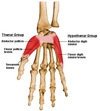
origin: pisiform
insertion: medial 5th proximal phalanx
innervation: ulnar nn
action: abduction of 5th digit, aids in flexion of proximal 5th phalanx
*hypothenar (muscles on medial side of palm, pinky)
Flexor Digiti Minimi

origin: hook of hamate & flexor retinaculum
insertion: medial 5th proximal phalanx
innervation: ulnar nn.
action: flexion of 5th proximal phalanx
*hypothenar






